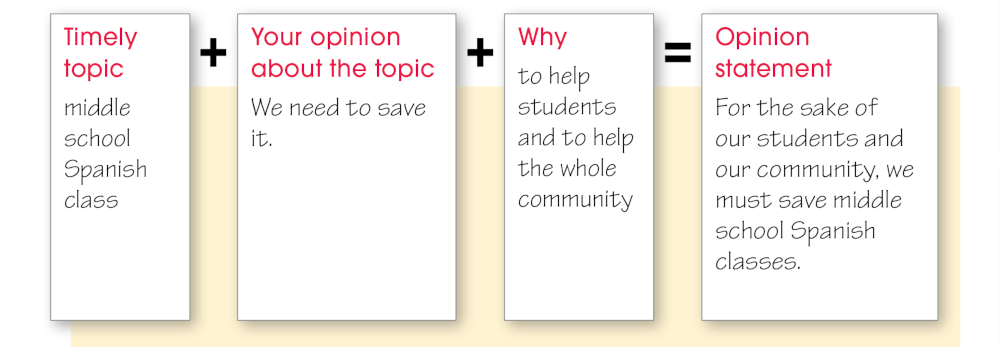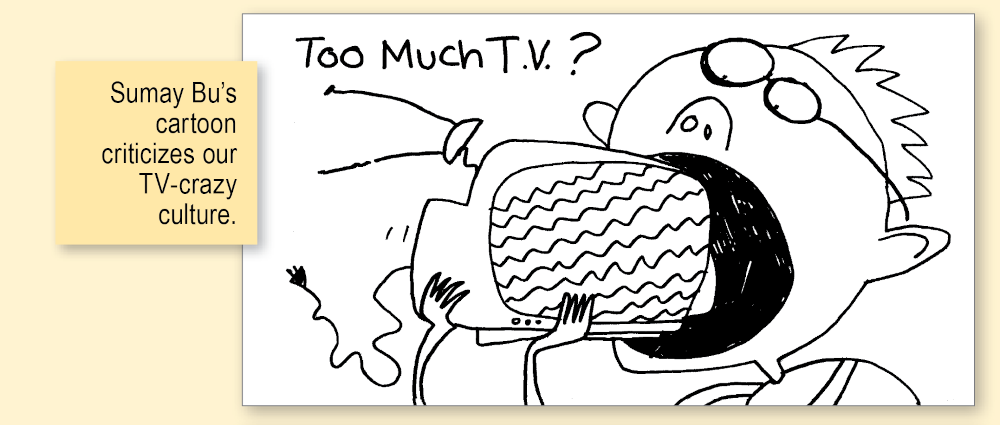WOC 255
Page 255
Writing Editorials and Cartoons

When you write a regular news story, people will tell you not to editorialize—which means not to share your own opinion. You’re supposed to objectively report the story, covering the 5 W’s and H.
When you write an editorial, you must editorialize. Tell us what you really think!
An effective editorial expresses an opinion about an important current topic. It argues for that opinion using strong reasons, and it answers any objections that readers might have.
Readers might hear your opinion and respond, “Yeah, but . . .” That’s an objection. You need to answer it, and any other times that readers say, “Yeah, but . . .” Once you have answered their objections, they are much more likely to agree with you.
It’s time to tell us how you really feel. It’s time to editorialize!
What’s Ahead
WOC 256
Page 256
Editorial
In the following editorial, Aidan Davis presents his opinion that Spanish classes need to remain in the middle school despite district-wide budget cuts.
¡Viva el Español!
Beginning:
The beginning introduces the topic and presents the opinion statement (underlined). Can you read that headline? Many of your neighbors can because Spanish is their home language. I can read it thanks to Mrs. Reyes and her Spanish classes in Dover Middle School. The school board is planning cuts to classes in our school system, and middle school Spanish is one of the classes they are considering. For the sake of our students and our community, we must save middle school Spanish classes.
Middle:
The middle offers reasons supported by statistics, explanations, experiments, and logic. First of all, many residents of Dover are Spanish speakers. In the 2020 census, 13.5 percent of respondents were Hispanic or Latino. That’s an increase of almost 5 percent over the 2010 census level of 8.6 percent. If the trend continues, in 2030, Dover will be nearly 20 percent Spanish speaking, and it would be a shame if our middle school no longer offered Spanish.
Spanish class helps speakers of Spanish and of English. Often when families come to this country, the children lose their home language and simply learn English. Spanish classes help those students keep their home language. Classes also help native English speakers gain a second language. Middle school Spanish connects students from different backgrounds and enriches our community.
The writer counters an objection with his most important reason. Some people argue that we’ll still have Spanish in high school. However, middle school falls directly in the “sweet spot” for learning a new language. Joshua Hartshorne of Boston College led an Internet study that found that language is best learned starting by age 10. Learning becomes much harder after age 18. Our middle school Spanish classes teach students from 11–15 years old, allowing for the most language learning. If we cut Spanish classes in middle school, we leave just three years for students to effectively learn. If anything, Spanish should be offered in our grade schools as well as our middle school.
Ending:
The ending uses anecdotes and makes a final plea. Spanish class has made a huge difference for me. Not only have I become bilingual, but I met my best friend Miguel in class. We walk around town speaking Spanish, which helps me practice a lot. Because of Miguel, I’ve learned about Mexican culture and traditions. Mrs. Reyes’s classes opened a whole world to me. We can’t let that door be slammed. ¡Viva el Español!

WOC 258
Page 258
Writing Guidelines
Prewriting ■ Selecting a Topic
An editorial is your chance to tell people what you really think. Make it count! Start by picking a topic you feel strongly about. It should be timely and of interest to your audience. Begin your topic search by finding out what’s happening in your school and community.
If you can’t think of a writing idea, try using sentence starters like Aidan did for his Spanish class editorial.
Sentence Starters

Gathering Details
Do plenty of research before you begin writing your editorial. You will need convincing support for your opinion in order to develop an effective editorial.
Aidan researched the latest census data for his city and read about the best age for language learning. He also thought about how Spanish class had helped him. He created a quick list of reasons to keep middle school Spanish class.
Quick List

WOC 259
Page 259
Forming an Opinion Statement
Once you have researched your topic, you are ready to write an opinion statement. The opinion statement is a sentence that includes your opinion and the main reason for supporting it. Use the formula below to write an opinion statement for your editorial.

Organizing Your Argument
The key to any good editorial is a convincing argument. To be convincing, you must provide solid reasons for your own opinion and address objections. You can try one of these patterns of organization.

If you expect your audience to be receptive, you can begin by providing your reasons. Then, near the end, you can recognize an objection to your position and provide an answer. Answering an objection actually strengthens your argument.

If you expect your audience to be resistant, you can begin by addressing an objection and answering it. You’ve done this before in conversation—“Now, I know what you’re going to say. . . .” You can move your readers past their initial concerns and then provide the main reasons for your opinion.

If your audience will have multiple objections, you can answer each one individually. Each answer will remove one more argument against your position. These answers will also function as reasons in support of your argument.
WOC 260
Page 260
Writing ■ Developing the First Draft
Beginning ■ Begin your editorial with a paragraph that grabs the reader’s attention and includes your opinion statement. Notice how Aidan starts his editorial with a question about the topic.
Aidan’s Beginning

Middle ■ Next, write body paragraphs that build your argument in a logical way, address the opposing point of view.
Helpful Hint
Your writing voice should sound confident but not arrogant. Be polite when addressing and countering the other side of the argument.
Ending ■ Close your editorial with a strong statement that will stick in the reader’s mind.
Revising ■ and Editing ■ Improving the Writing
As you revise and edit your editorial, ask yourself if your work demonstrates the traits of effective writing. (Download this checklist.)
_____ Ideas Do I clearly state my opinion? Do I provide strong supporting reasons?
_____ Organization Do I organize my arguments in an effective way?
_____ Voice Is my voice polite and convincing?
_____ Word Choice Do I use strong action verbs and specific nouns?
_____ Sentences Do my sentences read smoothly?
_____ Conventions Does my writing follow the rules of punctuation, capitalization, spelling, and grammar?
WOC 261
Page 261
Editorial Cartoons
Cartoons are fun and entertaining, but they can also deliver a powerful message. Editorial cartoons use visual images and a few words to present an opinion. Most major newspapers have an editorial cartoonist on staff. Study how the following editorial cartoons respond to timely topics.


